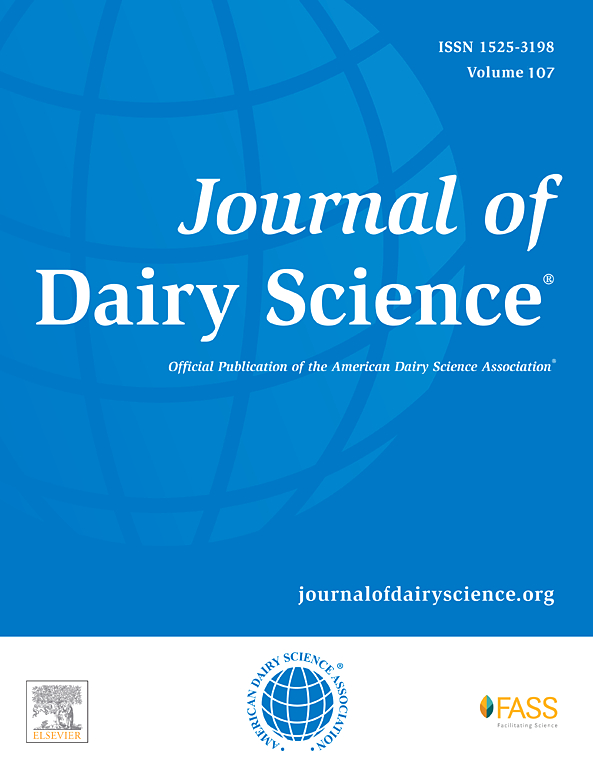用植物蛋白部分替代奶酪基底生产加工奶酪:质地、流变性、微观结构和感官特性
IF 4.4
1区 农林科学
Q1 AGRICULTURE, DAIRY & ANIMAL SCIENCE
引用次数: 0
摘要
在可持续性和健康问题的推动下,对植物性乳制品替代品的需求不断增长,推动了混合加工奶酪(PC)的发展,其中包括植物蛋白。本研究研究了用大豆分离蛋白(SPI)、豌豆分离蛋白(PPI)或绿豆分离蛋白(MBPI)代替5%的乳制品成分(马苏里拉奶酪基础)对杂交PC的质地、流变学、微观结构和感官特性的影响。质地分析表明,与SPI杂交PC表现出最高的硬度和嚼劲,归因于密集和内聚的蛋白质网络。流变学测试表明,混合PC均表现出剪切减薄行为和凝胶样性能,其中含SPI的混合PC表现出最高的粘弹性阻力。相比之下,混合PC与MBPI在纹理属性方面最接近乳制品PC。微观结构分析表明,混合PC形成了更密集的网络,脂肪滴更小,分布均匀。混合PC与SPI表现出最强的蛋白-脂肪相互作用,而与PPI表现出较弱的基质结构。感官评价表明,混合PC保持了可接受的感官品质,可与乳PC相媲美。值得注意的是,混合PC与MBPI实现了最接近乳制品控制的整体感官轮廓。主要由于2-戊基呋喃的存在,在混合PC与MBPI中最明显。然而,这种味道被胡椒醛和乙基香草醛平衡,这为混合PC贡献了乳白色和香草般的香气。这些发现强调了植物蛋白在保持感官可接受性的同时增强PC的营养、结构和流变特性的潜力。发现大豆分离蛋白具有优越的质地,而MBPI具有类似乳制品的感官品质,为传统乳制品PC提供了可持续的高蛋白替代品。本文章由计算机程序翻译,如有差异,请以英文原文为准。
Partially substituting cheese base with plant proteins to produce processed cheese: Textural, rheological, microstructural and sensory properties
The increasing demand for plant-based dairy alternatives, driven by sustainability and health concerns, has driven the development of hybrid processed cheeses (PC) that incorporate plant proteins. This study investigates the effects of replacing 5% of the dairy component (Mozzarella cheese base) with soy protein isolate (SPI), pea protein isolate (PPI), or mung bean protein isolate (MBPI) on the textural, rheological, microstructural, sensory properties of hybrid PC. Textural analysis revealed that hybrid PC with SPI exhibited the highest firmness and chewiness, attributed to a dense and cohesive protein network. Rheological testing indicated that all hybrid PC displayed shear-thinning behavior and gel-like properties, with hybrid PC with SPI showing the highest viscoelastic resistance. In contrast, hybrid PC with MBPI most closely resembled dairy PC in terms of textural attributes. Microstructural analysis demonstrated that hybrid PC formed denser networks with smaller, well-distributed fat droplets. Hybrid PC with SPI showed the strongest protein-fat interactions, whereas with PPI exhibited a weaker matrix structure. Sensory evaluation revealed that hybrid PC maintained acceptable sensory qualities comparable to dairy PC. Notably, hybrid PC with MBPI achieved the closest overall sensory profile to the dairy control. The presence of a beany flavor, primarily due to 2-pentylfuran, was most pronounced in hybrid PC with MBPI. However, this flavor was balanced by piperonal and ethyl vanillin, which contributed milky and vanilla-like aromas to the hybrid PC. These findings highlight the potential of plant proteins to enhance the nutritional, structural, and rheological properties of PC while maintaining sensory acceptability. Soy protein isolate was found to offer superior texture, whereas MBPI replicated dairy-like sensory qualities, providing a sustainable and high protein alternative to traditional dairy PC.
求助全文
通过发布文献求助,成功后即可免费获取论文全文。
去求助
来源期刊

Journal of Dairy Science
农林科学-奶制品与动物科学
CiteScore
7.90
自引率
17.10%
发文量
784
审稿时长
4.2 months
期刊介绍:
The official journal of the American Dairy Science Association®, Journal of Dairy Science® (JDS) is the leading peer-reviewed general dairy research journal in the world. JDS readers represent education, industry, and government agencies in more than 70 countries with interests in biochemistry, breeding, economics, engineering, environment, food science, genetics, microbiology, nutrition, pathology, physiology, processing, public health, quality assurance, and sanitation.
 求助内容:
求助内容: 应助结果提醒方式:
应助结果提醒方式:


